MRM Research Roundup: End-of-January 2020 Super Bowl Edition
26 Min Read By MRM Staff
This edition of Modern Restaurant Management (MRM) magazine's Research Roundup features an economic report from Yelp, super Super Bowl stats, delivery trends, megatrends, best cities for BBQ and top venues.
Yelponomics
Yelp released its first-ever annual Yelp Economic Average (YEA) report, a benchmark of local economic strength in the U.S. The report found that most local economies nationwide slumped in 2019, down 1.3 percent from the previous year, led by underperformance in restaurant, food and nightlight categories, as well as brick-and-mortar shops. A weak fourth quarter, down 1.4 percent, largely contributed to the 2019 drop and marked the largest quarter-over-quarter decline since 2018. The report also found that businesses in states that voted Republican in the 2016 presidential election outpaced the economic growth of businesses in states that voted Democratic.
YEA is calculated starting from the fourth quarter of 2016 nationally, as well as in 50 metros and every state including Washington D.C., reflecting data from millions of local businesses and tens of millions of users on Yelp’s platform. The report measures local economic strength through business survival and consumer interest. According to researchers, Yelp provides a timely and accurate measure of a huge swath of the economy that is often missed by many major indicators.
“The slowdown in overall economic growth in 2019 reflected business profits declining, which contributed to a fall in business investments. Uncertainty around trade policy also hindered local economic growth in 2019,” said Carl Bialik, Yelp’s data science editor. “For every quarterly release since the introduction of YEA in Jan. 2019, its change from the prior quarter has matched the change in GDP growth. If GDP continues to move the same way YEA does, we can expect the GDP growth in the fourth quarter of 2019 to show a decline from the third quarter’s level of a 2.1 percent increase.”
Republican States Have Outperformed Democratic States Since 2016
YEA found businesses in states that voted Republican in the 2016 presidential election had greater economic growth than businesses in states that voted Democratic – the local economies of blue states lagged behind red states by 2.8 points relative to 2016, widened from a gap of 1.3 points in 2018. The red-blue local-economy gap persists in all four major regions of the country: the Northeast, South, Midwest, and West.
Four out of the top five states with the strongest local economies in the U.S. voted Republican in 2016 – North Dakota, South Dakota, Wyoming, and Alaska – with services sectors and several food-related economic growth trended blue — Washington D.C., Illinois, Massachusetts, Connecticut, and California — primarily led by declines in retail businesses.
A Tough Year for Retail, Food, and Auto Businesses
Three crucial sectors dragged down the local economy in 2019 and each one is expected to keep falling in the beginning of 2020.
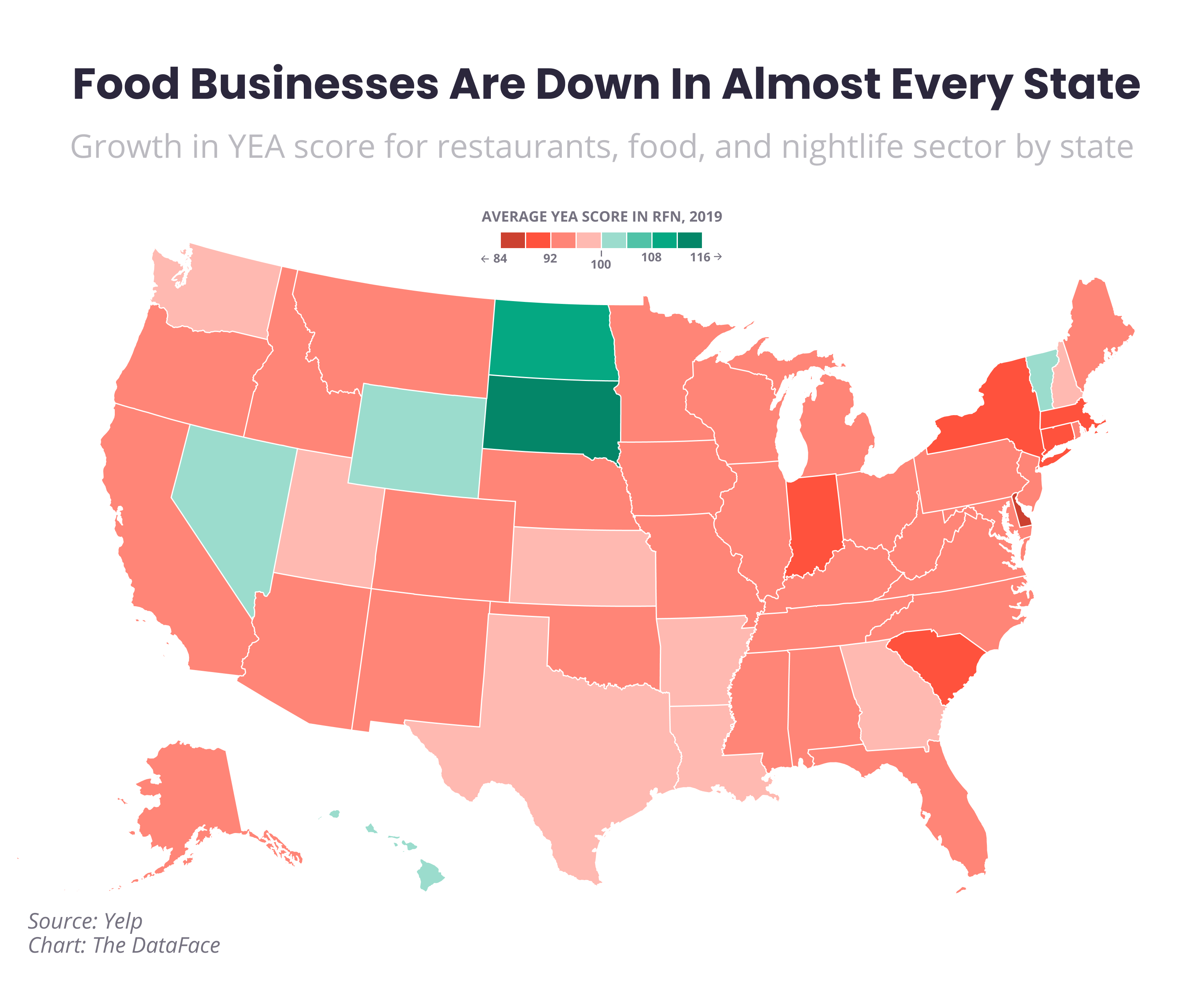
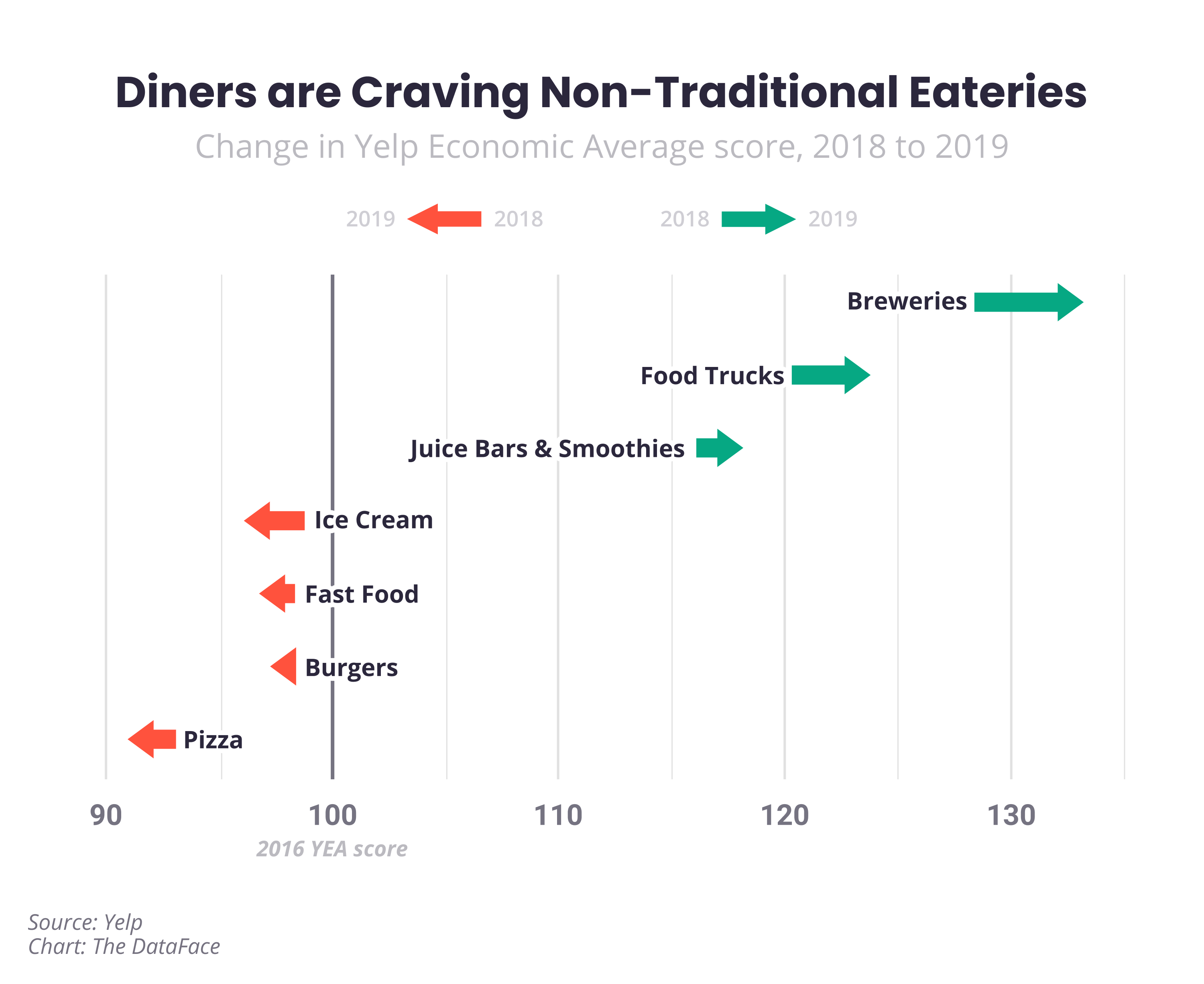
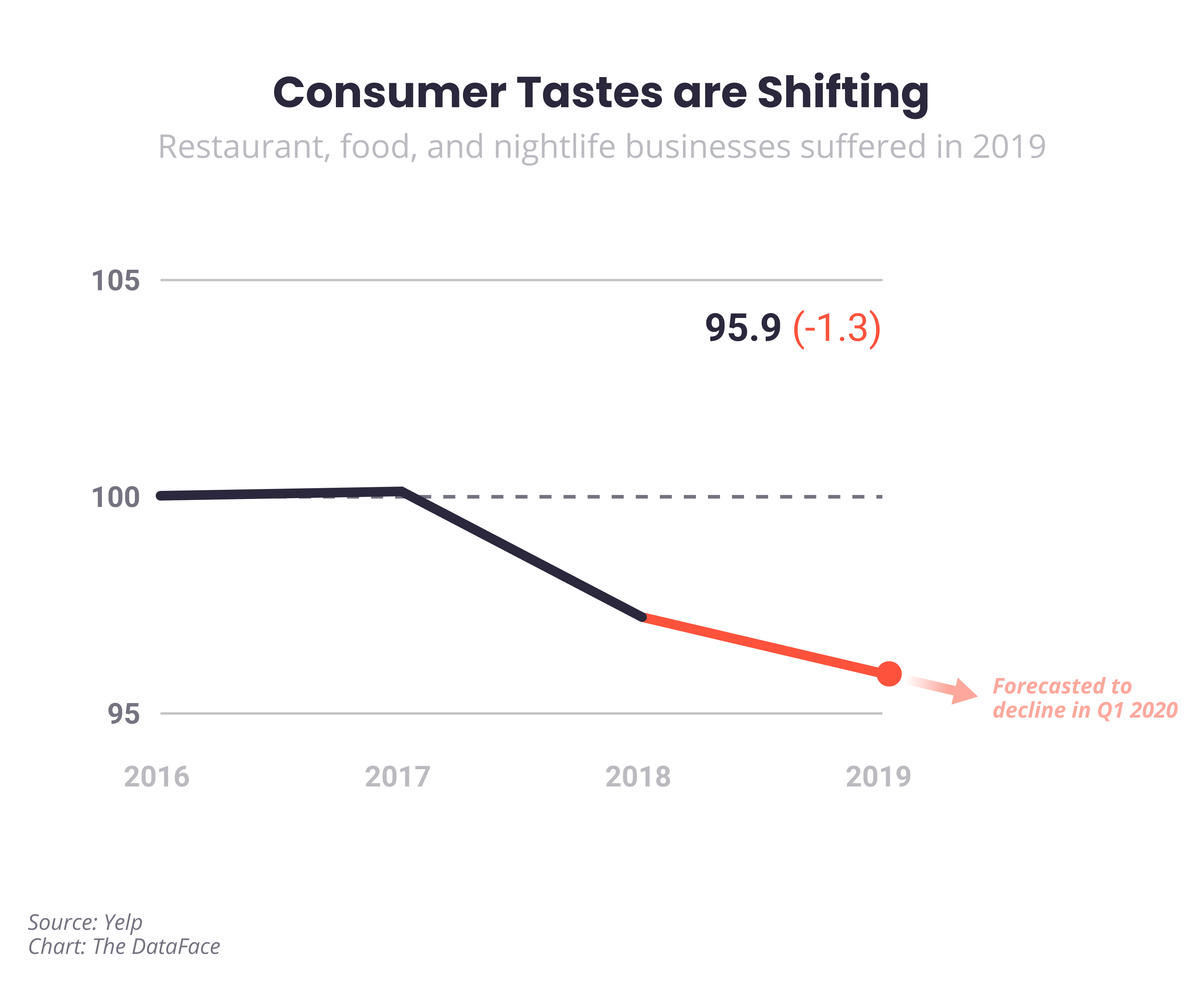
Shopping categories declined in 2019 by 2.1 points year-over-year, driven down by a weak holiday shopping period. The weakest business categories varied by type and price point, and included stores selling mobile phones, shoes, and appliances.
Restaurant, food, and nightlife businesses were collectively down by 1.3 points in 2019 from a year earlier, driven by declines across ice cream, grocery stores, and New American cuisine categories. Fast-food restaurants also took a hit, down 1.5 points from 2018 as diners opt for less standard dining and drinking options, such as breweries (up 4.8 points), food trucks (up 3.5 points), and juice bars (up 2.2 points).
Auto businesses also slumped, down 2 points from a year earlier, reflecting the possible effect of ride-sharing’s popularity on auto businesses, such as gas stations and auto-repair shops that rely on high driving levels in the general population.
Smaller States and Metros Gained Economic Ground in 2019
The top metros in 2019, among the 50 major metros around the country we’re tracking, were Milwaukee; Honolulu; Portland, Maine; Buffalo; and Pittsburgh. Services businesses fueled gains in these metros, with some gains across food and nightlife businesses. Orlando, New Orleans, and two of the 2019 boomtowns — Portland and Honolulu — look most likely to continue to succeed in the first quarter of 2020.
States with the most economic growth in 2019 were the Dakotas, Wyoming, Hawaii, and Alaska, with growth driven by services sectors and several restaurant and food businesses. Continued gains are expected in some of these top-performing states, as well as in Maine, Louisiana, and Nevada.
The bottom five metros in 2019 include Portland, Oregon; Dallas; Chicago; San Jose; and San Francisco. Among the 50 states and Washington D.C., the five lowest rates of economic growth since 2016 were posted by Washington, D.C.; Illinois; Massachusetts; Connecticut; and California. Retail businesses led the decline, across these metros and states. While California’s economy is the fifth largest in the world, it ranked fifth from the bottom in YEA for 2019. Oregon, Delaware, and Oklahoma are expected to fall in the first quarter of 2020, along with continued declines from D.C. and Connecticut.
The team at Upserve pulled data from all of their restaurant database to find out some trends surrounding Super Bowl Sunday. To learn more, click here.
- In-House restaurant sales go down 20 percent overall
- Delivery and To-Go orders are up 14 percent
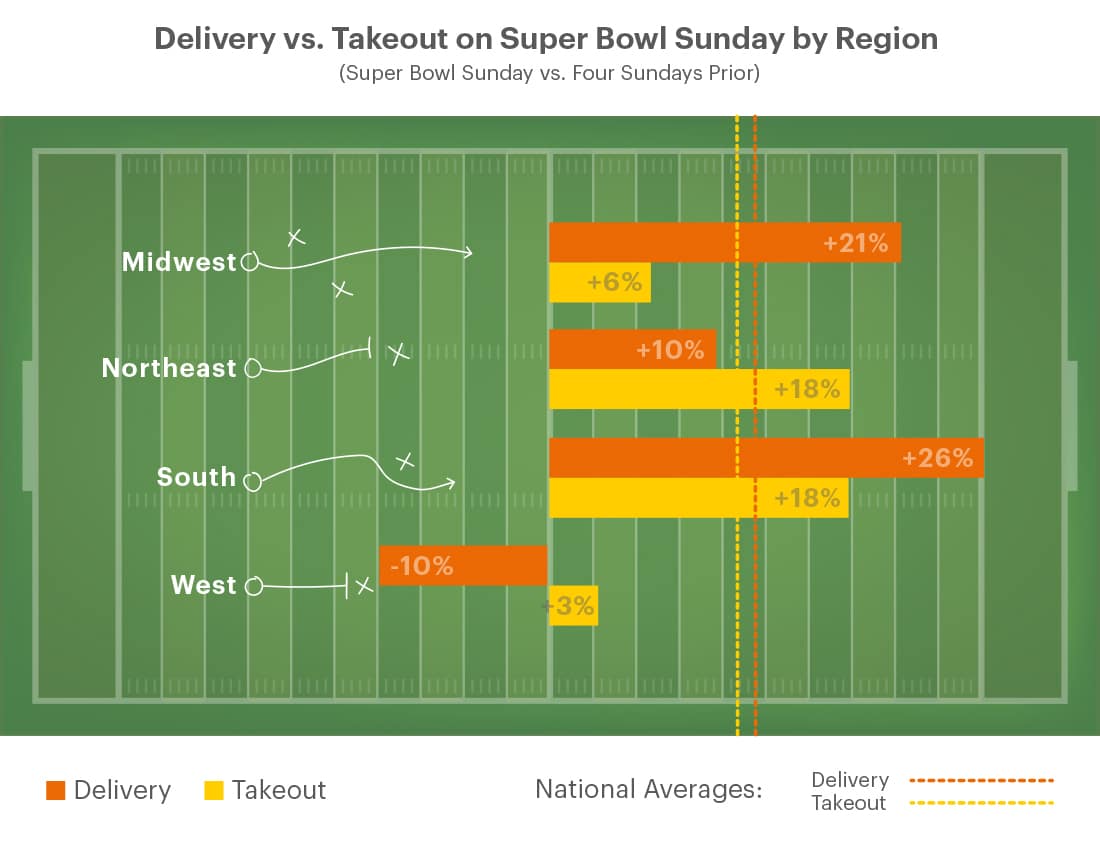
- Pizza and Wing sales are the most popular Super Bowl Snacks
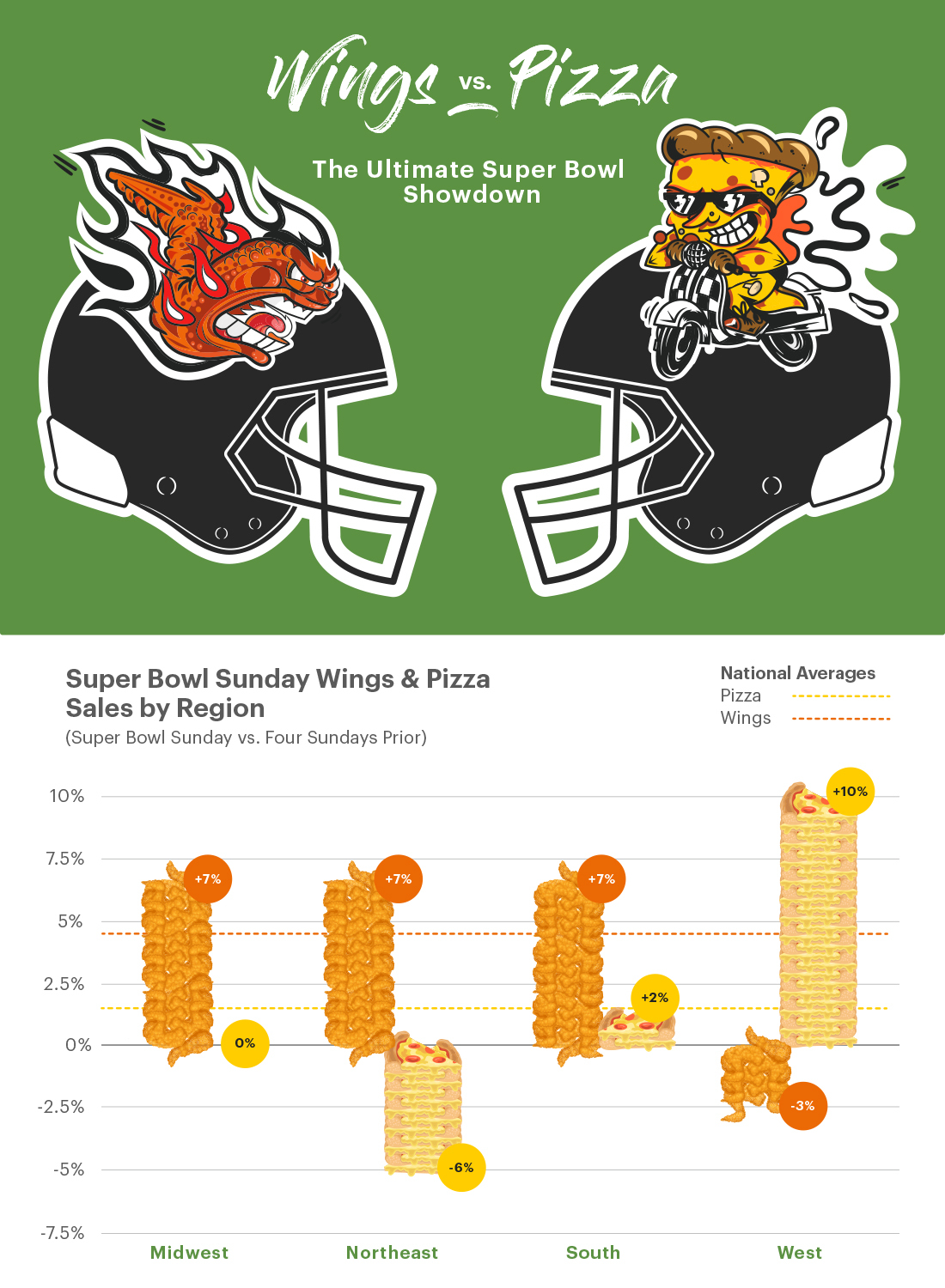
In a preview of the next big day, Upserve also pulled data for Valentine's Day which will be published in an eBook next week.
Among the highlights:
- Restaurant Sales overall go up 65 percent
- Reservations increase 72 percent
- The average ticket amount is up 18 percent
- Wine sales are up 101 percent
Be Careful on the Couch
As millions of America’s sit in their living rooms to watch the big game, many will turn to their favorite QSRs to provide their favorite football foods. Spectators are expected to spend $17.2 billion on party supplies – 80 percent of which will be on food and beverage. While the Super Bowl is primed to be a big day for QSRs, it’s also an opportunity for fraudsters to take advantage of the surge in online orders.
According to a report from Sift:
- 62 percent are concerned that their interactions with QSRs will lead to some type of fraud, whether it’s stolen payment information, account takeover, hijacked loyalty rewards points, or fake reviews
- 49 percent are most concerned about their credit card data being stolen
- If fraud occurs, 49 percent will hold the restaurant or delivery service directly responsible
Aramark's Megatrends
The start of a new decade brings a time of reflection and positive change, including what will influence the food decisions we make. Aramark, the largest U.S.-based food service company, asked its top chefs to share their thoughts about the top food trends of 2020. These trends are cutting edge, and may not always go mainstream, but they help influence what you’ll find in a grocery store or café near you in the months ahead.
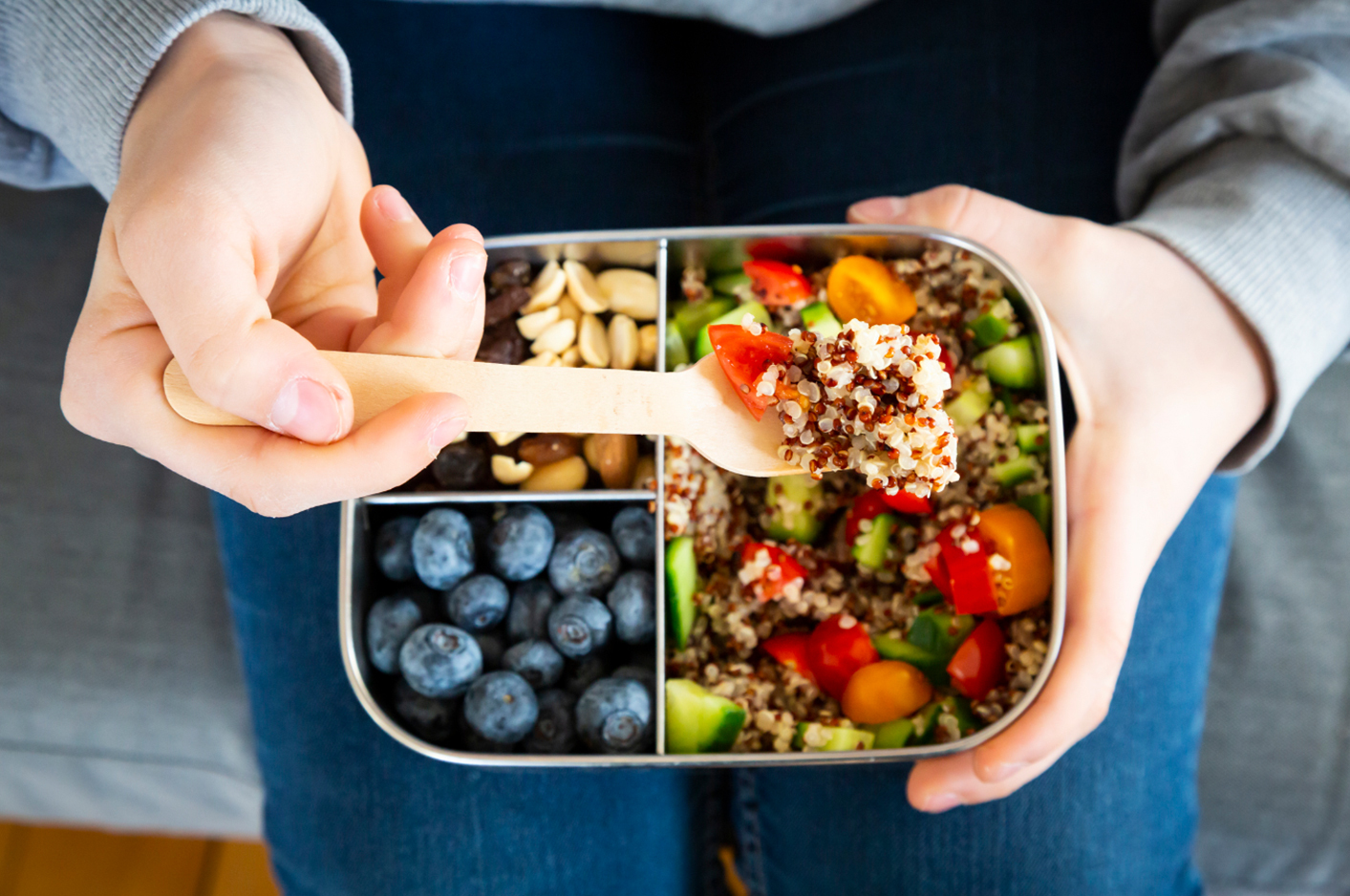
Plant Forward
As more people focus on their general health and the environment, putting more plants on the plate is a natural way to reduce the amount of meat in a meal. For example:
Milk Alternatives: Mainstream options like almond and soy milk will continue to be joined by more and more plant-based alternatives such as oat, cashew and sunflower milk.
Flour Alternatives: Watch as flour variations made from fruits and vegetables, like banana flour and split-pea flour, become more available.
Protein Options: Soy isn’t the only plant-based protein in town. Mung bean, hempseed and avocado will have a moment in 2020.
Syrup Swaps: Need a touch of natural sweetness? More people are looking beyond honey, to alternatives made from pomegranates, coconut and monk fruit, to name a few.
New Butters and Spreads: High-quality, traditional butter is enjoying a resurgence. At the same time, the marketplace is awash with new plant-based options. Look for heart-healthier spreads made from the oils of olives, avocados, almonds and more.
Sustainability
Consumers want to know the story behind their food. In addition to shorter ingredient lists, products will showcase how they match up with evolving values in a few ways:
Plant Inclusion: In addition to being good for you, plant-forward meals help reduce greenhouse gas emissions that harm our atmosphere. They also help preserve other vital resources like land, energy and water.
Ethical Sourcing: Food labels go beyond nutritional information. Increasingly, they provide details on other practices like fair trade, animal welfare and local sourcing. Expect this trend to continue as more and more ingredients and products highlight additional information about where they came from, how they were grown or raised and the individuals or communities who provided them.
Packaging: The concern the public has with plastic pollution is putting pressure on food companies to find sustainable alternatives. Whether it’s to-go boxes, or at-home leftover containers, expect to see more of a move toward eco-friendly and reusable materials. Aramark is committed to reducing waste before it’s generated. We are reducing single-use plastics, introducing reusable containers and working with suppliers to innovate packaging.
Superfoods
In 2020, there will be a renewed focus on functional properties of food and what they can do for your body. For example:
- More products featuring berries and olive oil—two sources of antioxidants that fight disease and promote healthy aging. There are also foods thought to help improve and enhance cognitive function. A few examples are turmeric, wild blueberries, salmon, broccoli, walnuts, egg yolks and seaweed.
- The rise of healthy indulgences—snacks and other products enriched with nutrient-dense foods. These better-for-you foods may have a dose of added superfood, like spinach-based pasta. Another example is high-protein ice cream, which contains less sugar and fewer calories than the traditional scoop.
Adventure
As international travel becomes more accessible there will be a globalization of flavors. For example:
New tastes and ingredients, used in unique combinations, with greater focus on the flavor source. Instead of sweeping terms like “Mexican,” there might be references to regions, such as Veracruz, Oaxaca or Yucatan. Similarly, “Southern” food may be identified as having roots in Appalachian, Lowcountry or Creole cuisine.
“Exploring Aramark’s 2020 food megatrends can be a fun and delicious way to try new foods and incorporate plant-forward options into your diet, but there are no individual magic foods to make you healthier,” said American Heart Association Chief Medical Officer for Prevention Eduardo Sanchez, M.D., M.P.H., FAAFP. “For optimal health, consume a diet with a variety of foods, including vegetables, fruits, nuts, whole grains and healthy protein.”
Shifting Delivery Landscape
Motus released its new report, “The Shifting Landscape of Delivery Trends.” The report examines the current state of delivery in the U.S. and identifies trends. Some of those trends include popular delivery times, items and platforms, key differences of in-house vs. third-party delivery drivers and the potential impact new legislation could have on the entire delivery industry.
According to the report, Motus estimates that there will be 2.6 billion food deliveries made in 2020 to 101 million delivery users in the U.S. Of those deliveries, 48 million people across the country will order delivery on Super Bowl Sunday, one of the biggest food delivery days of the year with 80 percent of people planning to order out. During the game, pizza chains normally sell 30-40 percent more slices than they sell on a typical Sunday. A surprising 3 percent of all third-party food deliveries for 2020 will occur on this single day.
The report also found that the third-party delivery market is rapidly gaining scale, growing nearly five times faster than the total food industry. Since 2017, the delivery provider landscape has consolidated to the four companies dominating third-party delivery: DoorDash (37 percent), Grubhub (30 percent), UberEATS (20 percent) and Postmates (10 percent), with other services rounding out the remaining 3 percent of the market. These services will account for 70 percent of all delivery orders by 2022, with the user base expected to increase 53 percent by 2024. The report additionally discovered that location makes a difference on which delivery service users prefer. In Los Angeles, Postmates is a favorite, while users in Seattle tend to use UberEATS. Boston and Chicago users gravitate more towards Grubhub for their respective areas.
“As the food delivery market continues to evolve, it’s important for restaurants to evaluate the costs associated with in-house vs. third-party delivery, as driver wages are a huge factor,” said Ken Robinson, market research analyst for Motus.” In the same regard, it’s crucial that delivery drivers understand what their options are when considering a career in food delivery. One of the biggest considerations is transportation cost and reimbursement. The cost to drive can vary widely among U.S. cities, so a flat delivery fee or estimated mileage allowance may not be an accurate or fair reflection of the actual costs to complete a delivery.”
To illustrate this concept, the report compared delivery driving costs across major U.S. metros and found that the costs to make a delivery in Los Angeles are about 14 percent higher than a worker making a similar delivery in Boston. The report also breaks down how big of a difference mileage reimbursement can make in daily earnings, highlighting how reimbursement can even offset the difference in reported hourly wage.
“A growing number of states are adopting laws that require employers to make employees whole when they use personal assets like vehicles or mobile devices for work purposes,” said Danielle Lackey, Chief Legal Officer of Motus. “Simultaneously some states are seeking to expand the definition of ‘employee’ to include a broader worker-base. California recently made headlines when it signed Assembly Bill 5 (AB5) into law, changing how the distinction between independent contractors and employees is evaluated. Even while AB5’s application is working its way through the courts, it reflects a growing trend of greater scrutiny regarding fair and accurate worker compensation. It’s crucial that employers stay ahead of this if they want to avoid becoming the target of a costly lawsuit.”
To access the full report, click here.
Tripleseat’s Most Booked Venues
Tripleseat released their list of the most booked venues of 2019 in a few of the top cities across the United States. Whether it's for a birthday, graduation, engagement, bridal or baby shower, the list is comprised of more than just restaurants, hotels, and event halls. Unique venues that feature bowling alleys, cooking schools, and even ping-pong tables are among the most booked venues.
"There is an elevated importance on finding venues that offer not just great food and drinks, but unique experiences with added features that make a wedding, birthday or dinner party stand out from the rest, and our 2019 data confirms this," says Jonathan Morse, CEO of Tripleseat. "We hope to continue forging relationships with unique venues in the New Year to create authentic event experiences."
The venues are listed in alphabetical order for each city:
NEW YORK
Carmine's Times Square: Fantasizing about the South of Italy? Look no further than Carmine's which brings a Southern Italian family feast to the heart of New York's Times Square. Known for their hearty portions of all your favorite Italian dishes, each item is meant to be shared around the table.
Eataly NYC Downtown: Eataly is an Italian food lover's dream. With the option to dine-in, take a panini or gelato to-go, or browse around the many specialty markets, Eataly is the one-stop-shop for all of your Italian cravings. And if simply eating the food isn't enough, they also have a cooking school where you can master your favorite Italian dishes.
Eataly NYC Flatiron: People can't seem to get enough of Eataly, as both New York locations topped the list this year. With plenty of Italian delicacies to choose from, such as hand-made pasta, a curated selection of Italian wines and cocktails, Eataly can take your party to the next level.
Lucky Strike Manhattan: Conveniently located near Times Square Lucky Strike Manhattan is a destination that can accommodate all of your entertainment needs. Lucky Strike Manhattan is home to 26 state-of-the-art lanes, 11 tournament-quality billiards tables and a LuXe lounge that also doubles as a private event space.
Planet Hollywood New York: Located steps from all major hotels in Times Square, Planet Hollywood is a great central location to host your next celebration. Planet Hollywood New York can accommodate large receptions, plated dinners, networking events and parties. Your guests can enjoy a night of mingling while surrounded by some of Hollywood's most iconic memorabilia.
SAN FRANCISCO
Giants Baseball: When it comes to making memories, Giants Enterprises believes in being bold as illustrated by past programming including the notable sports events such as the 34th America's Cup and Rugby World Cup Sevens, along with exclusive private dinners, meetings and receptions at 15 iconic park venues, inside 3 transformable spaces on the park's edge and on two luxury yachts. Giants Enterprises operates a daily tourism program at Oracle Park as well as The Gotham Club. At the intersection of sports, entertainment, meetings, events, tourism and hospitality, Giants Enterprises provides the rare combination of people and places to create Giant Impressions.
Lucky Strike San Francisco: Just a hop, skip and a jump away from AT&T Park, Lucky Strike is the perfect location for pre-and post-game events. Celebrate any occasion with some bites, booze, and bowling at Lucky Strike San Francisco. They offer 12 contemporary bowling lanes, private party rooms, full-service bars, and cutting edge audiovisual systems.
Spin San Francisco: SPIN San Francisco is the ultimate destination for game-lovers and event planners alike. By combining an unusual mixture of ping pong, design, music, and entertainment, SPIN San Francisco has created a venue that is suited for day and night, from one-of-a-kind corporate events to amazing kids' birthday parties. The venue features 18 ping-pong tables, full-service restaurant, full bar, private room, and an enclosed patio, all steps from the Moscone Center in the SOMA district. Check us out at any of our nine US locations! Come play with us!
Tacolicious North Beach: Spice up any party at Tacolicious with their delicious Mexican menu. Perfect for private dining or larger events, Tacolicious will not disappoint. Guests who try their "MF Chicken," tacos and signature cocktails will leave satisfied!
Wise Sons: At the forefront of Wise Sons' culinary mission is building a community through traditional Jewish comfort food. Known for making many of their dishes from scratch, they pair classic recipes with the best California ingredients. Some of their famous homemade items include: Jewish rye, hickory smoked pastrami, and house-baked bagels and bialys. Wise Sons also offers catering for a party of any size, whether it's meeting at your office, a private brunch, or a bat mitzvah. Wise Sons can bring the joy of Jewish tradition to your event.
LOS ANGELES
Buca di Beppo Farmers Market: With plenty of spaces to choose from, Buca di Beppo makes hosting a private event seamless. Choose from their "Fresh From Italy" menu for a true taste of Italian cuisine. Their menu features dishes from Bologna, Roma, and Parma. Manga!
fundamental LA: Working with some of the most beautiful spaces in LA, fundamental LA is a one-stop-shop for all of your event needs. They will pair the catering menu of your dreams with one of their beautiful partners' spaces to execute an event of any size.
HomeState: Get a taste of Texas without having to leave LA at HomeState. The Texas kitchen is known for their breakfast tacos on fresh flour tortillas, queso, Frito pies, and brisket, and will leave you wanting to come back for more.
Lucky Strike LA Live: Dance and bowl the night away at Lucky Strike LA. The large space is perfect for corporate events and private parties, such as bachelorettes and birthdays. The venue features 18 premium lanes, as well as an additional Luxe Lounge with four premium lanes, two completion-ready billiards tables, and a full-service private bar.
NeueHouse Hollywood: NeueHouse is a private workspace and cultural home for creators, innovators, and thought leaders. The venue offers members in the film, design, fashion, branding, architecture, and the arts dedicated workspaces, personalized services, and the opportunity to be a part of a meaningful dialogue with leading artists and thinkers. Located in the original CBS Studios — where genre-defining artists Orson Wells, Lucille Ball, the Beach Boys, and Bob Dylan all built their legacy — NeueHouse is the perfect venue to host an event of any size.
CHICAGO
City Winery Chicago: Calling music fans and wine lovers alike, City Winery Chicago is a one-of-a-kind location that can accommodate your unique event needs. With space for an intimate seated dinner or 750-person gala, wedding reception, corporate outing, or wine tasting, City Winery Chicago is a great venue to say "cheers" to any occasion.
Lucky Strike – Chicago Downtown: Lucky Strike Chicago is 36,000 square feet of fun! Their Chicago location offers upscale event spaces, sophisticated menus, full-service bars, and cutting edge audiovisual systems. Conveniently located next to FTW Chicago, this dynamic duo will leave you with an unforgettable night out.
Pinstripes – Chicago: Located in downtown Chicago, Pinstripes is a unique dining and entertainment destination. The 30,000-square-foot venue features an intimate Italian/American bistro, 11 upscale bowling lanes, seven bocce courts, unique private dining spaces, a beautifully appointed ballroom, and an outdoor patio and fireplace overlooking the Chicago River.
WhirlyBall Chicago: WhirlyBall Chicago combines the fun of WhirlyBall, Laser Tag, and bowling all under one roof. To round out their premium social experience, WhirlyBall also offers delicious food, an expansive craft beer program, and event spaces to accommodate groups of any size. From friendly competition and activities to tasty food and drinks, WhirlyBall is the perfect venue for your next event.
Yolk: At Yolk, they are passionate about breakfast and are constantly pushing the envelope with new and creative breakfasts, specialty juices and their own private label premium coffee. There are more than just eggs at Yolk — those with an appetite for lunch fare can choose from incredible salads, sandwiches, wraps, and burgers.
Eating Out Equals Poor Nutrition
The typical American adult gets one of every five calories from a restaurant, but eating out is a recipe for meals of poor nutritional quality in most cases, according to a new study by researchers at the Friedman School of Nutrition Science and Policy at Tufts University.
Published in The Journal of Nutrition, the study analyzed the dietary selections of more than 35,000 U.S. adults from 2003-2016 in the National Health and Nutrition Examination Survey (NHANES) who dined at full-service (those with wait staff) or fast-food restaurants, which included pizza shops and what has become known as fast-casual. The researchers assessed nutritional quality by evaluating specific foods and nutrients in the meals, based on the American Heart Association 2020 diet score.
At fast-food restaurants, 70 percent of the meals Americans consumed were of poor dietary quality in 2015-16, down from 75 percent in 2003-04. At full-service restaurants, about 50 percent were of poor nutritional quality, an amount that remained stable over the study period. The remainder were of intermediate nutritional quality.
Notably, the authors found that less than 0.1 percent – almost none – of all the restaurant meals consumed over the study period were of ideal quality.
“Our findings show dining out is a recipe for unhealthy eating most of the time,” said Dariush Mozaffarian, senior author and dean of the Friedman School. “It should be a priority to improve the nutritional quality of both full-service and fast-food restaurant meals, while reducing disparities so that all Americans can enjoy the pleasure and convenience of a meal out that is also good for them.”
The disparities documented by the study authors show some groups ate more healthfully than others while dining out. For example, the average quality of fast-food meals consumed by non-Hispanic whites and Mexican-Americans improved, but there was no change in the average quality of fast-food meals consumed by non-Hispanic blacks. Also, the proportion of poor-quality fast-food meals decreased from 74 percent to 60 percent over this period for people with college degrees, but remained high at 76 percent for people without a high school diploma.
The researchers also looked at the extent to which Americans relied on restaurants during the study period and found:
- Restaurant meals accounted for 21 percent of Americans’ total calorie intake.
- Full-service restaurant meals represented 9 percent of total calories consumed.
- Fast-food meals represented 12 percent of total calories consumed.
- Fast-food breakfasts increased from just over 4 percent to nearly 8 percent of all breakfasts eaten in America.
The researchers assessed specific foods and nutrients in restaurant meals and identified priorities for improvement. “We found the largest opportunities for enhancing nutritional quality would be adding more whole grains, nuts and legumes, fish, and fruits and vegetables to meals while reducing salt,” said first author Junxiu Liu, a postdoctoral scholar at the Friedman School. She noted the study findings showed no improvement in sodium levels in fast-food meals and worsening levels in full-service dishes consumed.
“Our food is the number one cause of poor health in the country, representing a tremendous opportunity to reduce diet-related illness and associated healthcare spending,” Mozaffarian said. “At restaurants, two forces are at play: what’s available on the menu, and what Americans are actually selecting. Efforts from the restaurant industry, consumers, advocacy groups, and governments should focus on both these areas.”
NHANES participants are representative of the national population and completed at least one valid 24-hour dietary recall questionnaire from nine consecutive cycles of NHANES between 2003-2016, including types of foods and beverages consumed and the source.
The study authors used the American Heart Association (AHA) diet score to assess meal quality, which is based on the AHA 2020 Strategic Impact Goals and is a validated risk factor for cardiovascular and metabolic outcomes. The AHA diet score includes both a primary and secondary score. The primary score assesses the consumption of fruits and vegetables, fish/shellfish, whole grains, sodium, and sugar-sweetened beverages, and the secondary score assesses intake of nuts/seeds/legumes, processed meat, and saturated fat.
Researchers also evaluated individual food groups and nutrients based on the USDA Food Patterns Equivalents Database (FPED) and MyPyramid Equivalents Database (MPED) associated with chronic illnesses.
Limitations of the study include the fact that self-reported food recall data is subject to measurement error due to daily variations in food intake. Participants may also overreport or underreport healthy or unhealthy foods due to social desirability perceptions.
This study is a part of the Food Policy Review and Intervention Cost-Effectiveness (Food-PRICE) research initiative, a National Institutes of Health-funded collaboration led by researchers at the Friedman School working to identify cost-effective nutrition strategies to improve population health in the United States.
Assessing Tropical Growth
Tropical Smoothie Cafe plans to open over 600 stores in the next few years. With a record-setting year of locations opened and franchise agreements signed, the company looks hot. But Placer.ai, , analyzed the data to find the smoothie company is hot in some areas but cool in others.
A link to the full report can be obtained here.
The smoothie highlights:
June, July and August 2018 brought in visits that were 6.0 percent above, 0.8 percent below and 4.8 percent above the baseline for the period from January 2018 through December 2019. 2019 numbers then spiked at 19.9 percent, 18.4 percent and 18.9 percent above the baseline, showing tremendous growth in this key period.
The smoothie lowlights:
Looking at three locations in Southern Florida shows a tremendous overlap of True Trade Areas, indicating that the locations are not just competing with other food options, but with each other, limiting the overall impact in the region.
Placer.ai believes the picture is not all bad. Looking at three locations in Georgia shows an excellent divide of True Trade Areas, indicating that when customers want to visit Tropical Smoothie Cafe, they know exactly which location to go to. Placer.ai states that this type of optimization maximizes the brand’s impact in the region, increasing the overall value for each location.
Choosing Sustainability
Tastewise, an AI-powered food intelligence startup, issues its latest report predicting sustainability trends for the food and beverage industry in 2020.
Plastic straws and packaging are hurting the planet, shopping local can reduce pollution, and meat alternatives are skyrocketing. Sustainability matters for the health of the planet, but what does it mean to consumers? Tastewise leverages real-time insights of consumers’ motivations and preferences to help companies advance products and practices to meet the needs of today’s sustainability trends and anticipate emerging food trends.
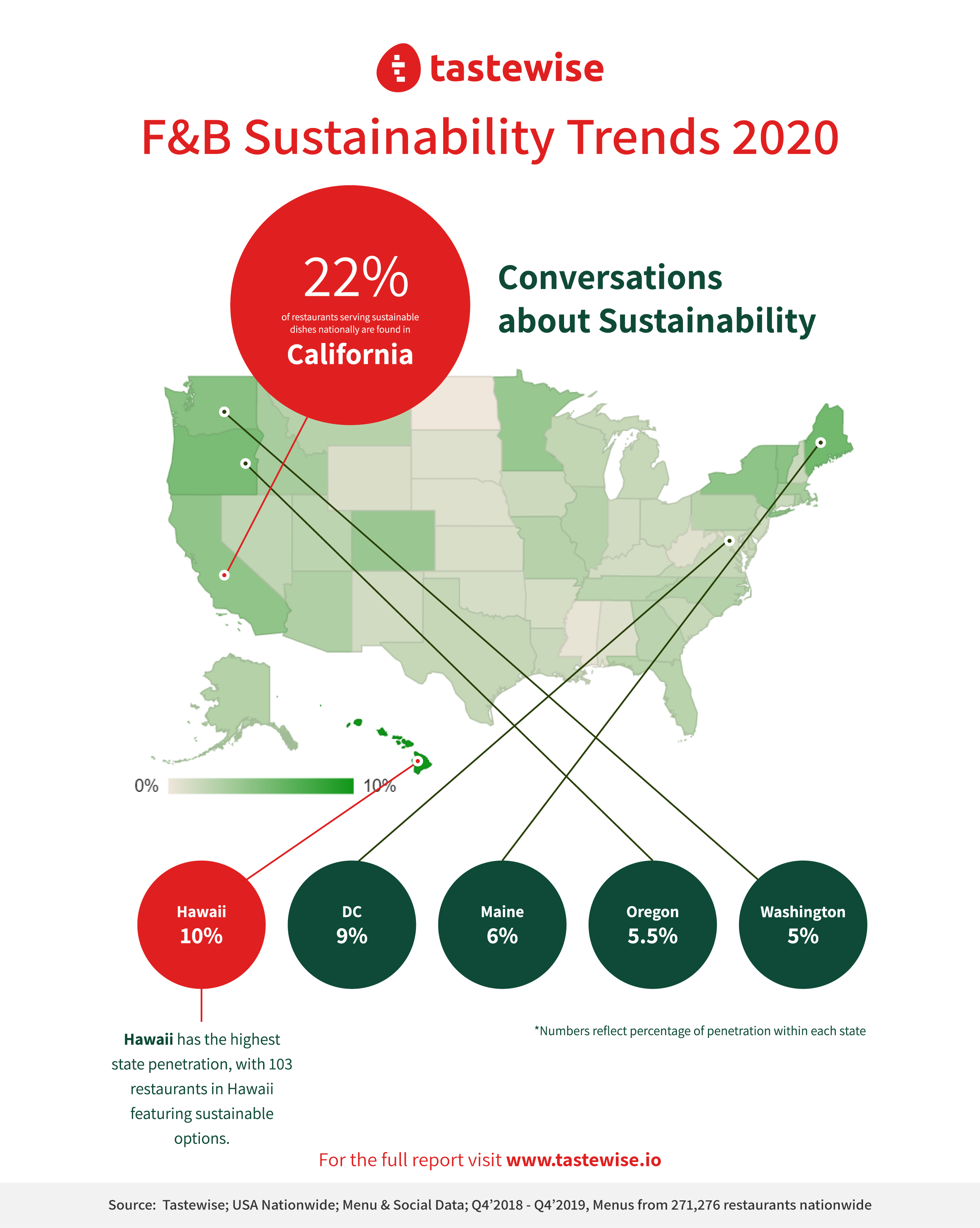
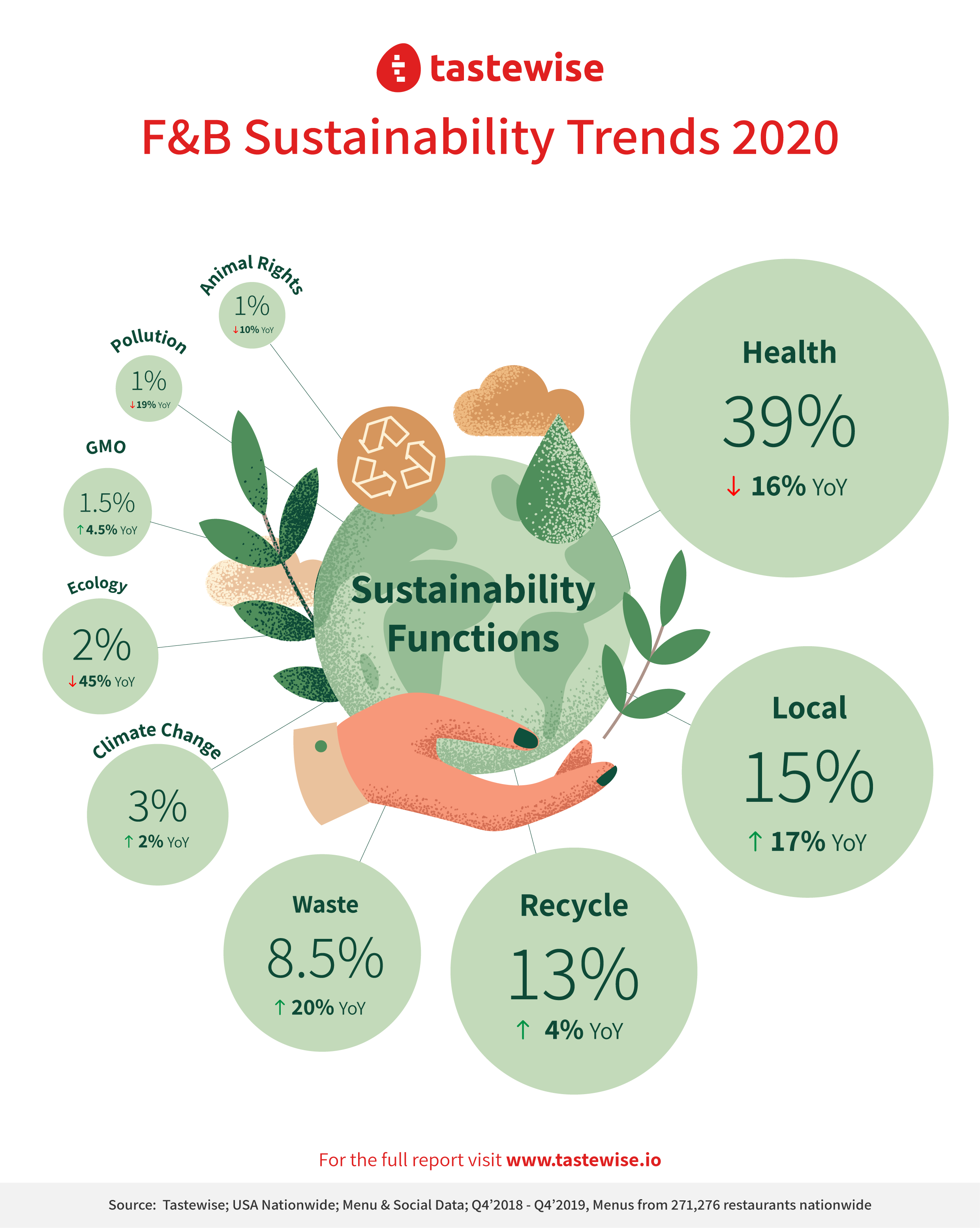
Analyzing over 2B social interactions, more than 3M online recipes, and the largest restaurant menu database available of 274K restaurants, the latest report from Tastewise forecasts industry changes in sustainability for the coming decade. The study discloses 23 percent more consumers prioritize sustainable food choices today than a year ago. Furthermore, the data-driven approach examines why.
For example, consumers’ eco-motivations and health needs eclipse all other factors when it comes to sustainable food, propelling the growing popularity of dark chocolate and cocoa beans.
Other highlights from the report include:
● While 39 percent of consumers’ sustainable conversations focus on health benefits, only 1 percent discuss animal rights, disproportionally to its impact on environment sustainability
● Meatless conversations are on the rise, with vegan diet proving most popular
● California leads the way in sustainability; with only 12 percent of US population, it’s home to 22 percent of sustainable restaurants
● Keto dieters are seeking suitable, sustainable meat options, while some are ready to avoid animal products altogether
● Seafood is taking over sustainable recipes, with pollock dominating sustainable seafood menus, and oysters rising fastest in discussions
● Juice and smoothie bars that promote sustainable packaging are benefiting from increased consumer excitement
● Healthy waffles and oats are on track to win the restaurant scene
“Sustainability is an issue that’s increasingly important across food categories and markets, and we’re excited to offer data that impacts the future of our industry,” said Alon Chen, Tastewise Co-Founder and CEO. “We are helping our clients on a daily basis to find the right sustainable solutions that meet their consumer needs of today, as well as tomorrow. If a menu or a product doesn't offer sustainable seafood, it’s time to catch up to consumers’ heightened culinary consciousness.”
The full Tastewise 2020 Food and Beverage Sustainability Trends report can be downloaded here.
Top BBQ Cities
Apartment Guide ranked every U.S. city by the percentage of barbecue restaurants to all restaurants to determine the top 10 best BBQ cities.
While barbecue hotbeds rate high on our list, several unexpected cities make their case for BBQ cred. To learn more, click here.
Starbucks or Dunkin'
Thanks to the popularity of the Pumpkin Spice Latte and Holiday Cup, consumers overwhelmingly chose to visit Starbucks over Dunkin during Q4 2019. In fact, 50 percent of Dunkin visitors also visited a Starbucks location during Q4, whereas only 16 percent of Starbucks visitors also went to Dunkin, demonstrating the loyalty of Starbucks customers vs Dunkin customers.
That’s according to location intelligence company, Cuebiq, which looked at Q4 footfall traffic to Starbucks ahead of its earnings announcement on 1/28.
Cuebiq’s analysis also revealed that at least 55 percent of Starbucks customers returned to a Starbucks after their first visit (in other words, made 2 or more visits) in Q4 2019, further showing the loyalty of Starbucks customers. On the other hand, 40 percent of Dunkin visitors made at least one return to a Dunkin.
And there’s a significant group of die-hard loyals, as well: 16 percent of Starbucks customers visited a Starbucks at least five times, while 10 percent of Dunkin customers visited a Dunkin at least five times.
Moreover, Starbucks had an 83 percent share of visits in Q4 2019. The total number of visits to both brands was 93.5 million in Q4 2019. Starbucks’ peak-visit days during Q4 2019 were 12/21 and 12/22 (the Sat. and Sun. before Christmas), with 1.4 million+ visits to a Starbucks location each respective day. There were also many visits to Starbucks on Black Friday (about 1.3 million visits).
Brand Loyalty Increases
Customer brand loyalty has increased on average 20 percent from 2019 to 2020 across 85 leading B2C, B2B, and D2C categories, which encompass 16 industry sectors and 833 brands, according to Brand Keys 25th annual Customer Loyalty Engagement Index® (CLEI), conducted by the New York-based brand engagement and customer loyalty research consultancy (brandkeys.com).
“Analysts, consulting firms, and research practices that declared brand loyalty dead are talking about a consumer loyalty model that expired in 1990,“ noted Robert Passikoff, president of Brand Keys. “Back then loyalty was a black-and-white issue for consumers. But loyalty didn’t die. Rather, it has evolved in a more complex marketplace with more sophisticated out-of-home restaurant patrons.”
How complex? In every restaurant sector (100 percent) the path-to-purchase category loyalty drivers have new, consumer-generated configurations. Attribute, benefit, and value components that form the components of those drivers have grown more complex, more connected, and more emotional in 85 percent of the sectors.
Restaurant Brands’ 2020 Loyalty Focus
Numbers in parentheses indicate YOY increases of in-market brand loyalty.
Chick-fil-A (Fast Casual +28%)
Dunkin’ (Out-of-Home Coffee +22%)
Domino’s (Pizza +13%)
Five Guys (Fast Food +12%)
Defining Loyalty For The 21st Century
“Two decades into the 21st century the world has more complex brand and mediascapes. It’s more data-rich and technologically-intensive. Consumers are more complex, connected, and complicated. They connect with each other before even considering connecting to a brand and assess loyalty relative to how they envision an ‘Ideal’ brand,” said Passikoff.
“It only takes a nanosecond for consumers to note how well a brand is ‘seen’ to meet their expectations for the path-to-purchase drivers that defines behavior toward and fidelity to a brand. That’s the 21st century version of brand loyalty,” said Passikoff. “Brands that can meet consumer expectations will always see higher levels of engagement, loyalty, and sales.”
Independent validations by the ARF verify that definition. Correlations between assessments based on this updated definition of loyalty and consumer behavior are 0.80+. “Marketers who focus on so-called ‘loyalty programs’ expecting real brand allegiance, totally miss the point,” noted Passikoff.
Orders Of Path-to-Purchase Loyalty Driver Change, Becomes More Complex
“Categories and brands are not static” noted Passikoff. “They change, and how consumers view, compare, and buy, are governed by the order and level of expectation of the key loyalty drivers in any category.”
Disruptive market forces, technology, innovation and relentless competition all play a part in how the order of loyalty drivers shift and why consumer-value components become more complex. “But the end results are predominantly driven by consumers’ attitudes and desires, much of which is unarticulated,” noted Passikoff, “and virtually all of which are emotionally-based.”
“Brand Keys’ predictive research methodology identifies shifts 12 to 18 months before they appear in traditional brand tracking, focus groups or traditional research surveys based on a 20th century definition of ‘loyalty’.”
The order of importance of drivers represents a value continuum that consumers navigate, largely unconsciously, in their purchase and loyalty journeys. Consumers hold specific expectations for each category loyalty driver and use their expectations for the Category Ideal as a “yardstick” against which they measure brand performance. Brands that best meet consumer expectations always have the most-loyal customers and, not-so-coincidently, the strongest sales and highest profits.
For example, below is the order of the path-to-purchase loyalty drivers for the Fast Casual restaurant category in 2019. The numbers in parentheses below the drivers indicate the percent-contribution the individual driver makes to brand loyalty. Changes of + 5% are significant at the 95% confidence level.
For the Fast Casual restaurant category in 2020, not only has the order of the loyalty drivers changed (and how consumers assess these brands), but the attribute, benefit, and value components that make up the drivers have become more complex, representing a genuine consumer perspective because the output of the model obviates the fact that consumers don't think how they feel, they don't say what they think, and don't do what they say they will.
Loyalty Harder For Brands In “Commoditized” Sectors
“The majority of 2020’s categories and brands will have to address these more complex paths-to-purchase loyalty drivers and more emotionally-based customer values,” noted Passikoff. “But some categories have been inert, without changes to the order of loyalty drivers and no added consumer-value complexity. These brands start to look like commodities and competing in a commoditized sector makes for a much tougher battle for loyalty.”
Categories approaching commodity status included: gasoline, beer, cosmetics (mass), pet food, home improvement retail, bottled water, yogurt products, economy hotels, and packaged cold cuts.
A complete list of the CLEI’s 85 categories and the brands that exhibited 2020 loyalty focus and best meet consumer expectations can be found here.
Defining The Loyalty Challenge
“Marketers face a three-part challenge to leverage brand loyalty – as opposed to relying on legacy point programs,” noted Passikoff.“ First, they need to recognize it is 2020, not 1985, and define ‘loyalty’ as it applies to today’s consumers and the emerging marketplace. Second, they need to define objectives based on how customers actually view their category and identify what consumers expect, not based on tweet-counts or NPS scores, but on actual loyalty assessments. Finally, marketers need to design tactics that provide emotional brand engagement, not just more devalued points.”
“Do all that, and you’ll have more engaged, more loyal customers which comes hand-in-hand with increased sales and profits. That’s what real loyalty is all about today. It’s also a pretty good definition of ‘successful marketing,’” noted Passikoff.
Foodservice Equipment Sales to Expand
Evolving food industry trends and changing dynamics of manufacturing and delivering methods in the foodservice industry are primarily shaping the market for foodservice equipment. Sales would multiply at a promising CAGR of over 5 percent during 2019 – 2029, as projected by a new market intelligence report.
Most restaurant owners are shifting towards smaller-sized kitchen equipment to optimize their space and perform multiple functions at the same time. Operators of food trucks and pop-up restaurants are on the lookout for equipment that can easily fit on a counter top and free up square footage for other essentials. These trends will remain pivotal in the market build-up over the following years.
Key Takeaways
- Food tourism – a new global trend especially in millennials has played a vital role in driving interest in food experiences and has led to increase in the number of food tour companies. This increase will continue to push demand for professional foodservice equipment for proper food handling and hygiene.
- Automatic, wireless, and aesthetic designs in foodservice equipment that fit in smaller floor spaces, and are amenable with rules set by regulatory bodies such as NSF, will gain more significance.
- Emergence of equipment with multifunctional capabilities will weigh heavy on conventional models in the near future.
- To gain an edge over competition and increase efficiency, restaurants and hotels are upgrading and replacing old foodservice equipment with convenient digital touch control foodservice equipment.
- By eliminating the usage of natural resources, key players are focused on introducing new equipment with energy efficiency capabilities, leading to improved cooking and production time.
- North America is projected to be a prominent regional market for foodservice equipment, owing to high demand for replacement and renovations, along with aftermarket parts and service offerings, especially in the U.S.
The demand for foodservice equipment is mainly defined by renovation activities and miniaturization of the equipment to fit in relatively small floor spaces. Product customization, with new space-saving installations in accordance with standards, rules, and codes will play an important role in the value chain of the market.
With more number of small-scale manufacturers having similar product offerings, the market structure would remain fragmented. Furthermore, the increasing number of players in the foodservice equipment market has been pushing manufacturers to include forward integration in terms of services and installation, by offering aftersales support. In terms of revenue, significant players such as Middleby Corporation, Welbilt, Ali Group S.r.l., ITW Food Equipment Group, AB Electrolux, Hoshizaki Electric Co., Ltd, Qingdao Haier Co., Ltd, and Rational AG together hold a significant share of market pie, backed by well-established sales networks and long-term partnerships with consumers.
Top manufacturers are strategically acquiring regional players to expand their global presence. For instance, Middleby Corporation has acquired Seattle-based Synesso, a designer and manufacturer of semi-automatic espresso machines. The company also acquired Brewtech, a market leader in professional craft brewing and beverage equipment, and Powerhouse Dynamics, Inc a leader in cloud-based IoT solutions for the foodservice industry.
These insights are based on a report on Foodservice Equipment Market by Future Market Insights.
How to Celebrate the Lunar New Year
For some, the new year is celebrated on January 1 with champagne and a kiss at midnight for good luck. Those who celebrate the Lunar New Year have a host of food traditions that symbolize wealth, health, and family unity. The Lunar New Year – also known widely as the Chinese New Year or the Spring Festival – falls on January 25, and to celebrate the Year of the Rat, DoorDash, the nation’s leading on-demand food platform, took a look at ordering trends over the past Lunar New Year celebrations, and analyzed whether or not celebrants are staying true to tradition and ordering foods that historically signify luck and fortune.
Some of the traditional lucky foods eaten on Lunar New Year with DoorDash data:
- Dumplings – Steamed dumplings are shaped like the ancient Chinese gold currency and represent wealth. On Lunar New Year 2019, potstickers were the 6th most ordered dish!
- Noodles – The longer the noodles, the longer the life of the person who consumes them. Pad Thai was the number 1 most ordered dish on DoorDash on Lunar New Year 2019.
- Rice – The stickiness of steamed jasmine rice is another symbol of a family “sticking” together. Fried Rice was the second most ordered dish on DoorDash on Lunar New Year 2019! Chicken Fried Rice was #9 on the list in 2019, as well.
- Garlic – Tradition has it that celebrants should eat lots of garlic to count all of the money they will make in the new year. It’s found in almost every Chinese dish, and on the top food ordered in 2019, it can be found in orange chicken, sweet & sour chicken, and more!
- Red foods – Red is the prominent color used in the Lunar New Year, and is associated with good luck, fortune, and joy. Sweet & sour chicken was the 7th most ordered food in 2019 during Lunar New Year!
- Rice balls – While rice cakes represent unity of family and prosperity in the year ahead, the round shape indicates a smooth year ahead, family reunion, and good luck. Mochi was the fourth most ordered dessert on Lunar New Year in 2019.
- Chicken – Chicken dishes connotes unity and a good marriage between families. Six of the top ten foods ordered on Lunar New Year in 2019 were chicken dishes!
The Top Trending Items Ordered on Lunar New Year:
Based on YoY growth in orders from 2018 to 2019:
- General Tso’s Chicken (+182 percent)
- Egg Roll (+130 percent )
- Crab Rangoon (+122 percent)
- Chicken Fried Rice (+109 percent)
- Orange Chicken (+99 percent)
The Top Trending Cities on Lunar New Year:
Based on YoY growth in orders from 2018 to 2019:
- Detroit (+2100 percent)
- Cleveland (+967 percent)
- Santa Rosa (+775 percent)
- Philadelphia (+408 percent)
- Baltimore (+401 percent)
Top ordered items on Lunar New Year in 2019:
- Pad Thai
- Fried Rice
- Mongolian Beef
- Sesame Chicken
- Orange Chicken
- Potstickers
- Chicken Lettuce Wraps
- Sweet & Sour Chicken
- Wonton Soup
- Chicken Fried Rice
Top ordered Asian Desserts for Lunar New Year in 2019:
- Banana Spring Rolls
- Vietnamese Chocolate Lava Cake
- Sticky Rice with Mango
- Mochi
- Fried Banana
Top Ordered Asian Restaurants for Lunar New Year in 2019:
- Tommy Thai, San Jose, CA
- Bonchon [National]
- Crouching Tiger Restaurant, Redwood City, CA
- Kansai, Oakland, CA
- Lucky Chinese Bistro, Mountainview, CA
- Best Wok Chinese, Brooklyn, NY
- First Wok, Cincinnati, OH
- Thai Spice, San Jose, CA
- New Station Restaurant, Sacramento, CA
- Monster Pho, San Francisco, CA
Top States That Ordered Most on Lunar New Year in 2019:
- California
- Texas
- Florida
- Ohio
- New York
- Colorado
- Georgia
- North Carolina
- Illinois
- Michigan
Top Cities That Ordered Most on Lunar New Year in 2019:
- Los Angeles, CA
- Oakland, CA
- San Mateo, CA
- San Jose, CA
- Houston, CA
- San Diego, CA
- Sacramento, CA
- Riverside, CA
- Denver, CO
- Dallas, TX

